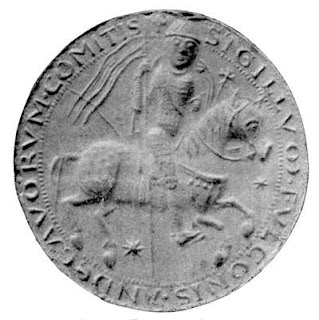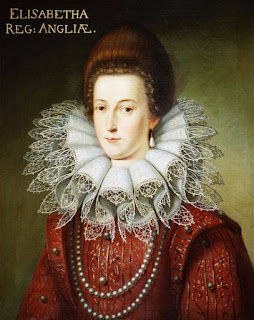Friday 29 June 2018
250) Oliver Cromwell
- “The embalmed head, still with its leathery skin and traces of gingery hair, found some repose with the early Russells. […]Do they need more than to be shown that the gruesome head, commensurate in size with what is known of Cromwell, still covered in skin with faint traces of reddish hair…” http://archive.spectator.co.uk/…/the-strange-tale-of-cromwe…
However, the authenticity of the head is not accepted by everyone.
249) Geoffrey V Plantagenet
- "On his wedding day, Geoffrey of Anjou was a tall, bumptious teenager with ginger hair, a seemingly inexhaustible natural energy and a flair for showmanship. His fair-skinned good looks earned him the sobriquet Le Bel. Tradition also has it that he liked to wear a sprig of bright yellow broom blossom (planta genista in Latin) in his hair, which earned him another nickname: Geoffrey Plantagenet...." http://spartacus-educational.com/MEDstephen.htm
248) Fulk V of Anjou
- “According to William, Fulk was "a ruddy man, like David... faithful and gentle, affable and kind... an experienced warrior full of patience and wisdom in military affairs." https://en.wikipedia.org/wiki/Fulk,_King_of_Jerusalem
- “He was also short, fat, red-haired and sixteen years older than his bride.” http://www.medievalqueens.com/queen-melisende-of-jerusalem.…
247) Fulk I of Anjou
- “Red hair was a distinguishing characteristic of the Angevin Counts. Fulk I. derived his name of Rufus from this peculiarity, which was inherited by many of his descendants, among them Fulk V., his son Geoffrey Plantagenet, and his grandson Henry Fitz-Empress.” https://books.google.it/books…
246) Ismail I
During Ismail's reign, mainly in the late 1510's, the first steps for the Habsburg–Persian alliance were set as well, with Charles V and Louis II of Hungary being in contact with a view to combining against the common Ottoman Turkish enemy.
- “Ismail was described by contemporaries as having a regal appearance, gentlemanly in quality and youthfulness. He also had a fair complexion and red hair. His appearance compared to other olive-skinned Persians, his descent from the Safavid Shaykhs, and his religious ideals, contributed to people's expectation based on various legends circulating during this period of heightened religious awareness in Western Asia.
“ This Sophi is fair, handsome, and very pleasing; not very tall, but of a light and well-framed figure; rather stout than slight, with broad shoulders. His hair is reddish; he only wears moustachios, and uses his left hand instead of his right.” https://en.wikipedia.org/wiki/Ismail_I
245) Catherine of Austria
244) Elizabeth of York
Therefore, she was the daughter, sister, niece, wife, mother and grandmother of successive Kings and Queens of England.
- "Elizabeth of York was a renowned beauty, inheriting her parents' fair hair and complexion. All other Tudor monarchs inherited her reddish gold hair and the trait became synonymous with the dynasty." https://en.wikipedia.org/wiki/Elizabeth_of_York
243) Charlotte of France
- "Charlotte was born in the Château d'Amboise, on 23 October 1516, the second daughter and child of King Francis I and Queen Claude. She had greenish blue eyes and bright red hair." https://www.revolvy.com/…/Charlotte%20of%20Valois&item_type…
242) Henry II of France
241) Christian II of Denmark
Thursday 28 June 2018
240) Giulia Beccaria
"She is beautiful and restless, with red hair and grey-green eyes. She is lively, intelligent and enthisiastic."
http://www.enciclopediadelledonne.it/biografie/giulia-beccaria/
239) Edith Wharton
"Her relations gave rise to the phrase 'keeping up with the Joneses'; but that did nothing to help the aspirations of an un-pretty, unfashionably red-headed little girl who was born to be remarkable. Almost symbolically, Edith's red hair remained defiantly unfaded until her dying day."https://www.telegraph.co.uk/books/authors/edith-wharton-a-magnificent-and-subtle-writer/
 |
| Portrait by Edward Harrison May |
 |
| Portrait by Edward Harrison May |
238) Oruç Reis
Oruç Reis (1474–1518). Ottoman corsair who became Sultan of Algiers. The elder brother of the famous Ottoman admiral Hayreddin Barbarossa, he was born on the Ottoman island of Midilli (Lesbos in present-day Greece) and died in battle against the Spanish at Tlemcen.
Barbarossa was the influence behind the character Captain Hector Barbossa from the movie Pirates of the Caribbean. It was revealed that co-star Johnny Depp played a decisive part in providing the name. His last name is both a pun on the surname of Spanish origin "Barbosa" and is based on Barbarossa, the Ottoman privateer. The word is a combination of the Italian words barba (beard) and rosso [feminine rossa] (red).
- "He became known as Baba Oruç or Baba Aruj (Father Oruç) when he transported large numbers of Morisco, Muslim and Jewish refugees from Spain to North Africa; folk etymology in Europe transformed that name into Barbarossa (which means Redbeard in Italian)."
https://en.wikipedia.org/wiki/Oru%C3%A7_Reis237) Sir Hudson Lowe
"...a man of about forty-five years of age, of the common height, slender make, with red hair ruddy, freckled complexion..."https://books.google.it/books
236) Hugh Judson Kilpatrick
"Described as short in stature, with red hair and stringy sand-colored side burns, he spoke in a shrill voice and walked in a rolling gate."http://www.thelatinlibrary.com/chron/civilwarnotes/kilpatrick.html
235) Nathaniel Lyon
He fought in the Second Seminole War and the Mexican–American War, before being sent to the divided state of Kansas, where he developed strong pro-Union views. In February 1861, Lyon was made commander of the Union arsenal in St. Louis, Missouri (another divided state), where Lyon forced the surrender of the pro-Confederate militia. This caused a riot by civilians, with Lyon’s troops firing into the crowd (Camp Jackson Affair). Lyon was promoted to brigadier general and was given command of Union troops in Missouri. He was killed at the Battle of Wilson’s Creek, while trying to rally his outnumbered soldiers. However, Lyon’s efforts had prevented the State of Missouri from joining the Confederacy.
234) George Armstrong Custer
"Custer himself has been depicted arrayed in a short jacket, an enormous red tie, and long red hair falling over his shoulders."https://www.kshs.org/p/the-pictorial-record-of-the-old-west-4/13042
"He had freckles, and reddish-blonde hair."https://www.esquire.com/news-politics/news/a23270/introducing-george-armstrong-custer-062813/
"Deep blue eyes and a shock of reddish blonde hair rounded out his features."https://truewestmagazine.com/the-civil-war-custer/
"He was an over the top character who loved publicity and gained more than other more accomplished officers, the press for their part loved him a young showman with long red hair and a taste for velvet jackets with gold braid he would not have been out of place in Napoleon's cavalry of half a century earlier."http://www.historyofwar.org/articles/people_custer.html
However, Plains Indians used to calling him "Yellow hair", so it's possible either he was a strawberry blond or, over the years, his hair turned to a sandy shade, which is not unusual for redheads before their hair becomes white.
233) George Bernard Shaw
- "At twenty, Shaw was tall, gangly, thin, pale, and red-haired, with sharp gray eyes, projecting ears, prominent brows, and an even more prominent nose."
https://en.wikipedia.org/wiki/George_Bernard_Shaw
- "A man with pallid skin and bright red hair and beard who read Marx's Das Kapital..." https://books.google.it/
- "Shaw said that his lovely fiery red hair went white overnight." https://worldconnect.rootsweb.ancestry.com/cgi-bin/igm.cgi?op=GET&db=pinkkrystal&id=I15881
- "He mentioned his pallid pitted skin and red hair like seaweed." https://spartacus-educational.com/FWWbeerbohm.htm
| Opzioni : Cronologia : Opinioni : Donate | Chiudere |
232) Sonia Rykiel
- “I was born with this bright red mane. My mother tried to dye my hair. Nobody had fiery-red hair in our family.”
https://www.anothermag.com/fashion-beauty/10997/a-tribute-to-sonia-rykiels-famous-red-hair
231) Anne Bonny
"It is recorded that Anne had red hair and was considered a "good catch", but may have had a fiery temper; at age 13, she supposedly stabbed a servant girl with a table knife."https://en.wikipedia.org/wiki/Anne_Bonny
230) John of Denmark
229) Dorothea of Denmark and Norway
228) Anne of Denmark
Although on some websites her hair is described as "fair" or "blonde", in several of her portraits it looks quite red.














































